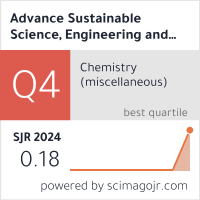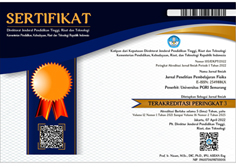Optimizing Human Resource Performance in Building Construction through Technology-Enhanced Strategy Development
DOI:
https://doi.org/10.26877/asset.v7i3.2083Keywords:
Performance , development strategy , human resources , construction , performance strategyAbstract
Construction projects involve complex processes requiring effective management and skilled human resources to ensure successful outcomes. This study analyzes key factors influencing human resource (HR) performance in building construction, identifying ability, working conditions, organizational structure, motivation, discipline, and compensation as critical determinants. A structured questionnaire using a 5-point Likert scale was employed as the data collection instrument, distributed to 130 contractors, with 114 valid responses collected in Semarang, Indonesia. Data analysis using SPSS v.27 confirmed that all indicators are valid, reliable, and positively perceived, with “ability” receiving the highest rating (mean = 4.8). Practical implications for project stakeholders include the need to implement targeted training, performance-based incentives, leadership development, and optimized recruitment. Technological integration is also emphasized for enhancing communication and decision-making efficiency. The findings underscore the importance of a comprehensive HR strategy that addresses both individual competencies and systemic organizational support, advancing sustainable engineering practices and improving project productivity in dynamic construction environments.
References
[1] M. Sajjad et al., “Evaluation of the Success of Industry 4.0 Digitalization Practices for Sustainable Construction Management: Chinese Construction Industry,” Buildings, vol. 13, no. 7, 2023, doi: 10.3390/buildings13071668.
[2] J. N. J. Binod Bhandari1, Roshan Adhikari2, “Relationship Between Human Resource Manag- ment Strategy Practice and Worker Performance,” J. Adv. Res. Constr. Urban Archit., vol. 9, no. 1, hal. 1–11, 2024, doi: 10.21063/JTS.2025.V1201.053-059.
[3] A. Ibrahim, T. Zayed, dan Z. Lafhaj, “Enhancing Construction Performance: A Critical Review of Performance Measurement Practices at the Project Level,” Buildings, vol. 14, no. 7, 2024, doi: 10.3390/buildings14071988.
[4] M. K. Buniya et al., “Critical success factors of safety program implementation in construction projects in Iraq,” Int. J. Environ. Res. Public Health, vol. 18, no. 16, 2021, doi: 10.3390/ijerph18168469.
[5] I. G. Alkandi, M. A. Khan, M. Fallatah, A. Alabdulhadi, S. Alanizan, dan J. Alharbi, “The Impact of Incentive and Reward Systems on Employee Performance in the Saudi Primary, Secondary, and Tertiary Industrial Sectors: A Mediating Influence of Employee Job Satisfaction,” Sustain., vol. 15, no. 4, 2023, doi: 10.3390/su15043415.
[6] A. S. El Touny, A. H. Ibrahim, dan H. H. Mohamed, “An integrated sustainable construction project’s critical success factors (Iscsfs),” Sustain., vol. 13, no. 15, 2021, doi: 10.3390/su13158629.
[7] D. Won, B. G. Hwang, dan S. J. Chng, “Assessing the effects of workforce diversity on project productivity performance for sustainable workplace in the construction industry,” Sustain. Dev., vol. 29, no. 2, hal. 398–418, 2021, doi: 10.1002/sd.2155.
[8] E. Nejatyan, H. Sarvari, S. A. Hosseini, dan H. Javanshir, “Determining the Factors Influencing Construction Project Management Performance Improvement through Earned Value-Based Value Engineering Strategy: A Delphi-Based Survey,” Buildings, vol. 13, no. 8, 2023, doi: 10.3390/buildings13081964.
[9] R. M. Shiferaw dan Z. A. Birbirsa, “Digital technology and human resource practices: A systematic literature review,” Heliyon, vol. 11, no. 2, hal. e41946, 2025, doi: 10.1016/j.heliyon.2025.e41946.
[10] Y. Chen, H. F. Gacheri, dan G. Sun, “Empirical investigation of building information modelling (BIM) staff’s impact on construction project performance: evidence in Kenya,” Front. Built Environ., vol. 10, no. August, hal. 1–23, 2024, doi: 10.3389/fbuil.2024.1441604.
[11] J. Cao, C. Liu, Y. Zhou, dan K. Duan, “Work-to-family conflict, job burnout, and project success among construction professionals: The moderating role of affective commitment,” Int. J. Environ. Res. Public Health, vol. 17, no. 8, 2020, doi: 10.3390/ijerph17082902.
[12] M. S. Ghattas, H. A. Bassioni, dan E. F. Gaid, “Human Resources Management influence on projects performance: A Study of Contractors Professionals Working on Construction Projects in Egypt,” IOP Conf. Ser. Earth Environ. Sci., vol. 1056, no. 1, 2022, doi: 10.1088/1755-1315/1056/1/012039.
[13] Rusdi kurniawan, “Identifikasi Faktor-Faktor Internal Dan Eksternal Yang Mempengaruhi Keberhasilan Proyek Konstruksi,” J. Ekon. Akuntansi, Manaj., vol. 2, no. 2, hal. 91–107, 2023.
[14] A. K. Bella Safira, Rismansyah, “Pengaruh Penghargaan Terhadap Kinerja Karyawan Melalui Loyalitas Pada PT. Bangun Cipta Anugrah Abadi Palembang,” J. Manage., vol. 17, no. 2, hal. 71–378, 2024.
[15] A. Yunita dan B. Hidayat, “Perbandingan Produktivitas Tenaga Kerja Proyek Konstruksi Pada Jam Kerja Normal Dan Lembur Di Kota Padang,” J. Bangunan Konstr. Desain, vol. 2, no. 3, hal. 180–190, 2024.
[16] A. Hajirasouli, A. Assadimoghadam, M. A. Bashir, dan S. Banihashemi, “Exploring the Impact of Construction 4.0 on Industrial Relations: A Comprehensive Thematic Synthesis of Workforce Transformation in the Digital Era of Construction,” Buildings, vol. 15, no. 9, hal. 1–24, 2025, doi: 10.3390/buildings15091428.
[17] W. Fei et al., “The critical role of the construction industry in achieving the sustainable development goals (Sdgs): Delivering projects for the common good,” Sustain., vol. 13, no. 16, 2021, doi: 10.3390/su13169112.
[18] Q. Wang, “Discussion of ‘Evaluation of Terrestrial and Mobile Scanner Technologies for Part-Built Information Modeling’ by Samad M. E. Sepasgozar, Perry Forsythe, and Sara Shirowzhan,” J. Constr. Eng. Manag., vol. 146, no. 3, hal. 1–2, 2020, doi: 10.1061/(asce)co.1943-7862.0001776.
[19] S. Jiang, Z. Li, R. Zhang, J. Zheng, dan S. Zhou, “A back-analysis method of deep excavation in soft soil based on BIM-NS-ML integrated technology,” Smart Constr., vol. 2, no. 1, hal. 1–2, 2025.
[20] B. Ramadan, H. Nassereddine, T. R. B. Taylor, dan P. Goodrum, “Impact of technology use on workforce performance and information access in the construction industry,” Front. Built Environ., vol. 9, no. February, hal. 1–15, 2023, doi: 10.3389/fbuil.2023.1079203.











